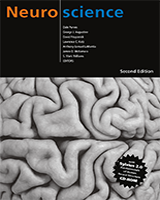By agreement with the publisher, this book is accessible by the search feature, but cannot be browsed.
NCBI Bookshelf. A service of the National Library of Medicine, National Institutes of Health.
Purves D, Augustine GJ, Fitzpatrick D, et al., editors. Neuroscience. 2nd edition. Sunderland (MA): Sinauer Associates; 2001.

Neuroscience. 2nd edition.
Show detailsMany peptides known to be hormones also act as neurotransmitters, and often these are co-released with small-molecule neurotransmitters. The biological activity of the peptide neurotransmitters depends on their amino acid sequence (see, for example, Figure 6.4). As already described, propeptide precursors are typically larger than their active peptide products and can give rise to more than one species of neuropeptide (Figure 6.14). Hence, the release of multiple neuroactive peptides from a single vesicle often elicits complex postsynaptic responses. Peptides are catabolized into inactive amino acid fragments by enzymes called peptidases, usually located on the extracellular surface of the plasma membrane. Some peptide transmitters have been implicated in modulating emotions (see Chapter 29). Others, such as substance P and the opioid peptides, are involved in the perception of pain (see Chapter 10). Still other peptides, such as melanocyte-stimulating hormone, adrenocorticotropin, and β-endorphin, regulate complex responses to stress. The large number of neuropeptide transmitters have been loosely grouped into five categories: the brain/gut peptides, opioid peptides, pituitary peptides, hypothalamic releasing hormones, and a catch-all category containing all other peptides not easily classified.

Figure 6.14
Proteolytic processing of the pre-propeptides, pre-proopiomelanocortin (A) and pre-proenkephalin A (B). For each pre-propeptide, the signal sequence is indicated in orange at the left; the locations of active peptide products are indicated by different (more...)
Substance P is an example of the first of these categories. The study of neuropeptides actually began more than 60 years ago with the accidental discovery of substance P, a powerful hypotensive agent. (The peculiar name derives from the fact that this molecule was an unidentified component of powder extracts from brain and intestine.) This 11-amino-acid peptide (see Figure 6.4) is present in high concentrations in the human hippocampus, neocortex, and also in the gastrointestinal tract; hence its classification as a brain/gut peptide. It is also released from C fibers, the small-diameter afferents in peripheral nerves that convey information about pain and temperature (as well as postganglionic autonomic signals). Substance P is also a sensory neurotransmitter in the spinal cord, where its release can be inhibited by opioid peptides released from spinal cord interneurons, resulting in the suppression of pain (see Chapter 10). The diversity of neuropeptides is highlighted by the finding that the gene coding for substance P also encodes a number of other neuroactive peptides including neurokinin A, neuropeptide K, and neuropeptide γ.
An especially important category of peptide neurotransmitters is the family of opioids. These peptides are so named because they bind to the same postsynaptic receptors activated by opium (see Chapter 10). The opium poppy has been cultivated for at least 5000 years, and has been used as an analgesic since at least the Renaissance. The active ingredients in opium are a variety of plant alkaloids, predominantly morphine. Morphine, named for the Greek god of dreams, Morpheus, is still one of the most effective analgesics in use today, despite its addictive potential (see Box D). Synthetic opiates such as meperidine and methadone are also used as analgesics, and fentanyl, a drug with 80 times the analgesic potency of morphine, is widely used in clinical anesthesiology.
The opioid peptides were discovered in the 1970s during a search for endogenous compounds that mimicked the actions of morphine. It was hoped that such compounds would be analgesics, and that understanding them would shed light on drug addiction. The endogenous ligands of the opioid receptors have now been identified as a family of more than 20 opioid peptides that fall into three classes: the endorphins, the enkephalins, and the dynorphins. Each of these classes are liberated from an inactive pre-propeptide (pre-proopiomelanocortin, pre-proenkephalin A, and pre-prodynorphin), derived from distinct genes. Opioid precursor processing is carried out by tissue-specific processing enzymes packaged into vesicles along with the precursor peptide in the Golgi apparatus (see Figure 6.14).
Opioid peptides are widely distributed throughout the brain and are often co-localized with other small-molecule neurotransmitters such as GABA and 5-HT. In general, these peptides tend to be depressants. When injected intracerebrally, they act as analgesics and have been shown to be involved in the mechanisms underlying acupuncture-induced analgesia. Opioids are also involved in complex behaviors such as sexual attraction and aggressive/submissive behaviors. They have also been implicated in psychiatric disorders such as schizophrenia and autism, although the evidence for this is debated.
Unfortunately, the repeated administration of opioids leads to tolerance and addiction. A better understanding of these neurotransmitters and their actions will be essential for developing strategies to deal with this extraordinary social and medical problem (Box D).
- Peptide Neurotransmitters - NeurosciencePeptide Neurotransmitters - Neuroscience
Your browsing activity is empty.
Activity recording is turned off.
See more...